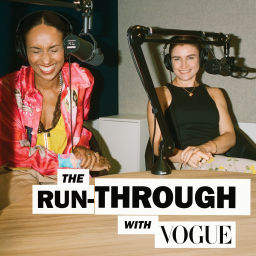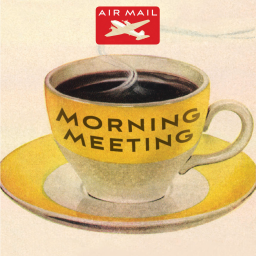
by The Business of Fashion
Welcome to The Debrief, a new weekly podcast from The Business of Fashion, where we go beyond the glossy veneer and unpack our most popular BoF Professional stories. Hosted by BoF correspondents Sheena Butler-Young and Brian Baskin, The Debrief will be your guide into the mega labels, indie upstarts and unforgettable personalities shaping the $2.5 trillion global fashion industry.<hr><p style='color:grey; font-size:0.75em;'> Hosted on Acast. See <a style='color:grey;' target='_blank' rel='noopener noreferrer' href='https://acast.com/privacy'>acast.com/privacy</a> for more information.</p>
Language
🇺🇲
Publishing Since
4/13/2022
Email Addresses
1 available
Phone Numbers
0 available

April 15, 2025
<p>In early April, President Donald Trump announced an unprecedented wave of tariffs, imposing duties as high as 145 percent on imports from China. Among the rationales offered were the prospect of a US manufacturing renaissance.</p><br><p>The American fashion sector – heavily reliant on overseas production, particularly in China – now faces significant disruption. Some brands are adapting quickly, leveraging their domestic operations and leaning into a ‘Made in USA’ identity. Others are reevaluating their reliance on China as their primary sourcing destination. But the prospect of a mass return of garment manufacturing jobs remains a remote possibility, most economists and fashion industry experts say. </p><br><p>In this episode of The Debrief, BoF correspondents Malique Morris and Marc Bain join executive editor Brian Baskin and senior correspondent Sheena Butler-Young to assess whether the dream of American-made fashion is any closer to reality.</p><br><p><strong>Key Insights: </strong></p><p><br></p><ul><li>The ‘Made in USA’ dream remains out of reach due to the lack of US manufacturing infrastructure. "The infrastructure just literally isn't here," says Bain. "Even if you use US grown cotton, most of the time that cotton is shipped out of the US to be spun into yarn and woven into fabric somewhere else. These are all sorts of things that we just don't have here. It's been lost over decades and it would take decades to get it back.”</li></ul><p><br></p><ul><li>Brands that already manufacture domestically are seeing success from marketing craftsmanship, experience and emotional value. The outdoor clothing company Filson, for example, offers walking tours around their manufacturing facility that shares a space with their Seattle headquarters. “Fashion is already an emotional purchase, and consumers do care about the story behind a brand. That's why brand marketing is so important for building the label,” says Morris. “This is another way to tap into that. It's storytelling, not nationalism.” </li></ul><p><br></p><ul><li>Whereas the US has a lack of infrastructure for manufacturing, China is in the exact opposite position. Small brands might have their supply chain concentrated in one geographical area and are especially vulnerable to tariff changes. “If that area happens to be China and suddenly there's this giant more than doubling of tariffs, you are in serious trouble,” says Bain. </li></ul><p><br></p><ul><li>Although cheap overseas clothing companies like Shein and Quince will now be subject to increased duties, consumers won’t abandon cheap fashion overnight. “Even if [middle-class shoppers] are not going to buy American-made brands that are significantly more expensive, maybe they'll go second-hand, maybe they'll vintage,” says Morris. “I think the hope here is that people will just get conditioned out of the idea that they can get $2 jeans and a $10 dress.”</li></ul><p><br></p><p><strong>Additional Resources:</strong></p><ul><li><a href="https://www.businessoffashion.com/articles/retail/how-made-in-usa-brands-benefit-from-tariffs/" rel="noopener noreferrer" target="_blank"><strong>How Made-in-America Brands Turn Tariff Turmoil Into Opportunity | BoF</strong></a></li><li><a href="https://www.businessoffashion.com/articles/retail/why-made-in-america-fashion-fantasy-manufacturing/" rel="noopener noreferrer" target="_blank"><strong>Why ‘Made in America’ Is Still a Fashion Fantasy | BoF</strong></a></li><li><a href="https://www.businessoffashion.com/articles/news-analysis/the-myth-of-made-in-america-ttp-agreement/" rel="noopener noreferrer" target="_blank"><strong>Unravelling the Myth of ‘Made in America’ | BoF</strong></a></li></ul><p><br></p><hr><p style='color:grey; font-size:0.75em;'> Hosted on Acast. See <a style='color:grey;' target='_blank' rel='noopener noreferrer' href='https://acast.com/privacy'>acast.com/privacy</a> for more information.</p>

April 8, 2025
<p>President Donald Trump announced an unprecedented wave of tariffs on April 2, imposing duties as high as 54 percent on fashion imports from key manufacturing countries, including China and Vietnam, and 20 percent on goods from the EU. These measures immediately sparked panic across global markets, ratcheting up the odds of a US recession and causing sharp stock price declines for major fashion brands such as Nike, Victoria's Secret and VF Corp. </p><br><p>Sustainability correspondent Sarah Kent and luxury correspondent Simone Stern Carbone join executive editor Brian Baskin and senior correspondent Sheena Butler-Young to break down the tariffs’ effects on manufacturing, luxury brands, consumer behaviour and potential future shifts within the industry.</p><br><p><strong>Key Insights: </strong></p><p><br></p><ul><li>The belief that these tariffs could quickly restore US-based fashion manufacturing is unrealistic. "It would take years of investment to build up the infrastructure and skill base within the US to replace manufacturing capacity that has been moving abroad for decades. For the apparel industry, it just does not exist on the scale that would be needed," explains Kent.</li></ul><p><br></p><ul><li>Luxury brands, traditionally insulated by European-based production, will also face pressure. "Even for luxury brands that pride themselves for their production in countries like mostly France and Italy, they are going to be hit with some tariffs too," Stern Carbone points out.</li></ul><p><br></p><ul><li>The tariffs introduce a complex challenge for luxury brands, requiring careful balancing of price adjustments, consumer sentiment and creativity amid ongoing economic uncertainty. "It's this mix between pricing, demand, maybe a lack of creativity, and also incentivising customers to actually purchase luxury goods," says Stern Carbone. "You don't know what [Trump] is going to do next, you don't know if this is going to stick, so are you going to spend $10,000 on a handbag - even if you can technically afford it - when you don't know what tomorrow brings?" emphasises Kent.</li></ul><p><br></p><ul><li>The industry isn’t entirely powerless. "Brands have a voice. Brands are part of the global economy. Brands can lobby," says Kent. "They can make it known that they don't like this. If you're not raising your voice and saying, 'hey, this is really hurting big business and it's not making America great again,' then you're not even trying."</li></ul><p><br></p><p><strong>Additional Resources:</strong></p><ul><li><a href="https://www.businessoffashion.com/articles/retail/trump-tariffs-fashion-supply-chain/" rel="noopener noreferrer" target="_blank"><strong>Trump’s Tariffs Rock Fashion’s Supply Chain | BoF</strong></a></li><li><a href="https://www.businessoffashion.com/articles/luxury/luxury-industry-trump-tariffs-impact/" rel="noopener noreferrer" target="_blank"><strong>Explainer: How Trump’s Tariffs Threaten Luxury Fashion | BoF</strong></a></li><li><a href="https://www.businessoffashion.com/opinions/retail/op-ed-fashions-reset-what-tariffs-are-forcing-us-to-finally-fix/" rel="noopener noreferrer" target="_blank"><strong>Op-Ed | Fashion’s Reset: What Tariffs Are Forcing Us to Finally Fix | BoF</strong></a><strong> </strong></li><li><a href="https://www.businessoffashion.com/case-studies/retail/executive-memo-an-action-plan-for-navigating-trumps-tariffs/" rel="noopener noreferrer" target="_blank"><strong>Executive Memo | An Action Plan for Navigating Trump’s Tariffs</strong></a><strong> </strong></li></ul><p><br></p><hr><p style='color:grey; font-size:0.75em;'> Hosted on Acast. See <a style='color:grey;' target='_blank' rel='noopener noreferrer' href='https://acast.com/privacy'>acast.com/privacy</a> for more information.</p>

April 1, 2025
<p>Fast-fashion giant H&M recently announced its plans to deploy AI-generated "digital twins" of real-life models in marketing campaigns. While H&M argues it's proactively managing inevitable industry changes, including by working with models to compensate them for use of their AI versions, the decision has sparked significant backlash. Comments on social media and statements by industry figures highlight deep-seated anxieties around job security, creative integrity and the value of the human element in fashion. </p><br><p>BoF correspondents Marc Bain and Haley Crawford discuss the potential outcomes and tensions arising from AI’s expanding role in fashion marketing.</p><br><p><strong>Key Insights: </strong></p><p><br></p><ul><li>H&M is just the tip of the iceberg: Fashion brands are increasingly embracing AI, from fast fashion to luxury. While AI-generated imagery has quietly infiltrated lower-end markets for some time, H&M's public embrace signifies its move out into the open, and into the world of high-profile campaigns. High-end brands like Coach and Estée Lauder have started using AI for product-focused imagery, indicating a cautious yet clear shift. "Coach uses Adobe Firefly to create digital twins of its products… to scale marketing content and test designs," says Crawford, highlighting how AI is already reshaping marketing across the fashion spectrum.</li></ul><p><br></p><ul><li>Transparency around AI use in marketing is still inconsistent, and regulations are lagging behind. "The technology is moving so rapidly, it's making its way out into the world already, and the law is trying to catch up," Bain explains. While the EU is moving toward legislating transparency in AI-generated imagery, the lack of clear rules globally adds complexity for brands and consumers alike, creating uncertainty around ethical marketing standards.</li></ul><p><br></p><ul><li>The rise of AI-generated imagery raises concerns over the loss of the creative collaboration intrinsic to traditional fashion shoots. "What's really at risk of being lost here is that communal process of creating fashion imagery," says Bain. "Some level of creativity and humanity, in addition to all the jobs themselves, which are also hugely important, will also be lost."</li></ul><p><br></p><ul><li>As AI image generation continues to be adopted by brands, it is creating increased competition, forcing both digital and traditional creatives to innovate further. "You can't only live in an endlessly self-referential cycle of AI image generation, even if AI is piecing different concepts together to generate newness," Crawford says. "People working on photography, art, whatever the artistic format is, will only get more creative and people are going to experiment more to stand out."</li></ul><p><br></p><p><strong>Additional Resources:</strong></p><ul><li><a href="https://www.businessoffashion.com/articles/technology/hm-plans-to-use-ai-models/" rel="noopener noreferrer" target="_blank"><strong>H&M Knows Its AI Models Will Be Controversial | BoF</strong></a></li><li><a href="https://www.businessoffashion.com/articles/technology/the-fake-fashion-campaigns-that-show-ais-future-in-marketing/" rel="noopener noreferrer" target="_blank"><strong>The Fake Fashion Campaigns That Show AI’s Future in Marketing | BoF</strong></a></li></ul><p><br></p><hr><p style='color:grey; font-size:0.75em;'> Hosted on Acast. See <a style='color:grey;' target='_blank' rel='noopener noreferrer' href='https://acast.com/privacy'>acast.com/privacy</a> for more information.</p>

The Business of Fashion

Glossy

Audacy | Puck

Vogue

Who What Wear

Liv Perez

Chris Black & Jason Stewart / Talkhouse

Nymphet Alumni

Goop, Inc. and Audacy

Eyewitness Beauty

Dressed Media

Clare Press

Second Life

Air Mail

Throwing Fits
Pod Engine is not affiliated with, endorsed by, or officially connected with any of the podcasts displayed on this platform. We operate independently as a podcast discovery and analytics service.
All podcast artwork, thumbnails, and content displayed on this page are the property of their respective owners and are protected by applicable copyright laws. This includes, but is not limited to, podcast cover art, episode artwork, show descriptions, episode titles, transcripts, audio snippets, and any other content originating from the podcast creators or their licensors.
We display this content under fair use principles and/or implied license for the purpose of podcast discovery, information, and commentary. We make no claim of ownership over any podcast content, artwork, or related materials shown on this platform. All trademarks, service marks, and trade names are the property of their respective owners.
While we strive to ensure all content usage is properly authorized, if you are a rights holder and believe your content is being used inappropriately or without proper authorization, please contact us immediately at [email protected] for prompt review and appropriate action, which may include content removal or proper attribution.
By accessing and using this platform, you acknowledge and agree to respect all applicable copyright laws and intellectual property rights of content owners. Any unauthorized reproduction, distribution, or commercial use of the content displayed on this platform is strictly prohibited.